cruise control Oldsmobile Achieva 1998 Owner's Manuals
[x] Cancel search | Manufacturer: OLDSMOBILE, Model Year: 1998, Model line: Achieva, Model: Oldsmobile Achieva 1998Pages: 356, PDF Size: 18.04 MB
Page 94 of 356
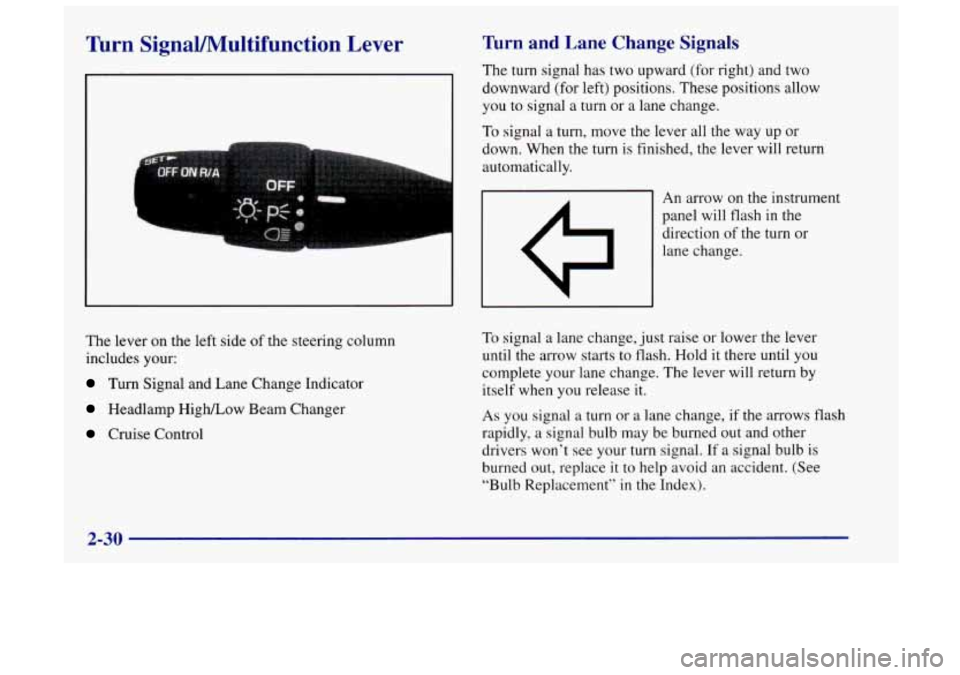
Turn SignaVMultifunction Lever Turn and Lane Change Signals
The turn signal has two upward (for right) and two
downward (for left) positions. These positions allow
you to signal a turn or a lane change.
To signal a turn, move the lever all the way up or
down. When the turn is finished, the lever will return
automatically.
An arrow on the instrument
panel will flash in the
direction
of the turn or
lane change.
The lever
on the left side of the steering column
includes your:
Turn Signal and Lane Change Indicator
Headlamp High/Low Beam Changer
Cruise Control To
signal a lane change, just raise
or lower the lever
until the arrow starts to flash. Hold it there until you
complete your lane change. The lever will return by
itself when you release
it.
As you signal a turn or a lane change, if the arrows flash
rapidly, a signal bulb may be burned out and other
drivers won’t see your turn signal.
If a signal bulb is
burned out, replace it to help avoid an accident. (See
“Bulb Replacement”
in the Index).
2-30
Page 97 of 356
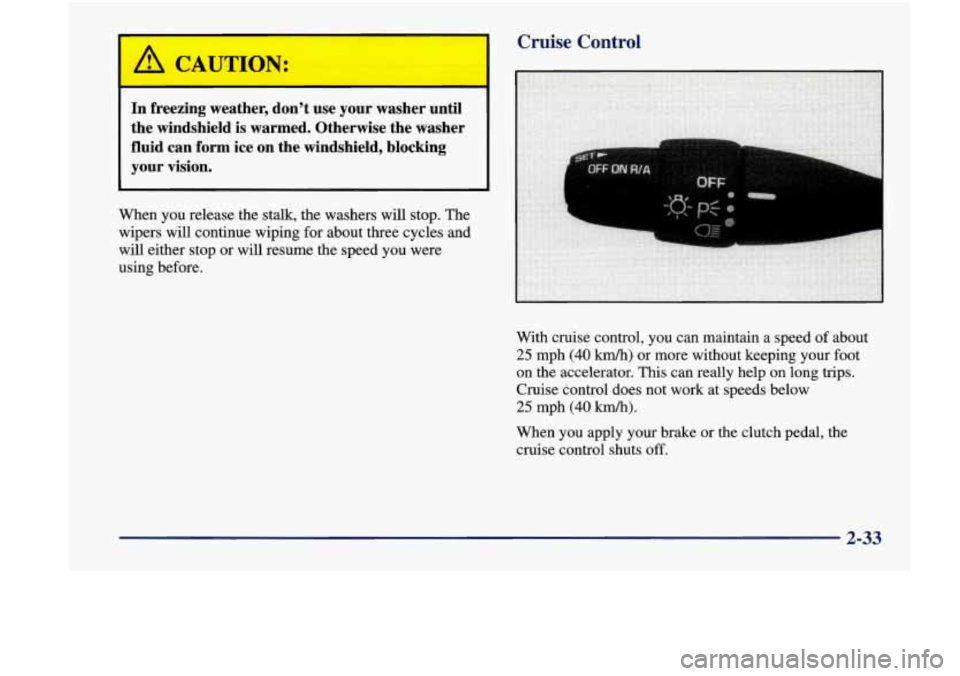
Cruise Control
In freezing weather, don’t use your washer until
the windshield is warmed. Otherwise the washer
fluid can form ice on the windshield, blocking
your vision.
When you release the stalk, the washers will stop. The
wipers will continue wiping
for about three cycles and
will either stop or will resume
the speed you were
using before.
With cruise control, you can maintain a speed of about
25 mph
(40 km/h) or more without keeping your foot
on the accelerator. This can really help on long trips.
Cruise Control does not work at speeds below
25
rnph (40 km/h).
When you apply your brake or the clutch pedal, the
cruise control shuts
off.
2-33
Page 98 of 356
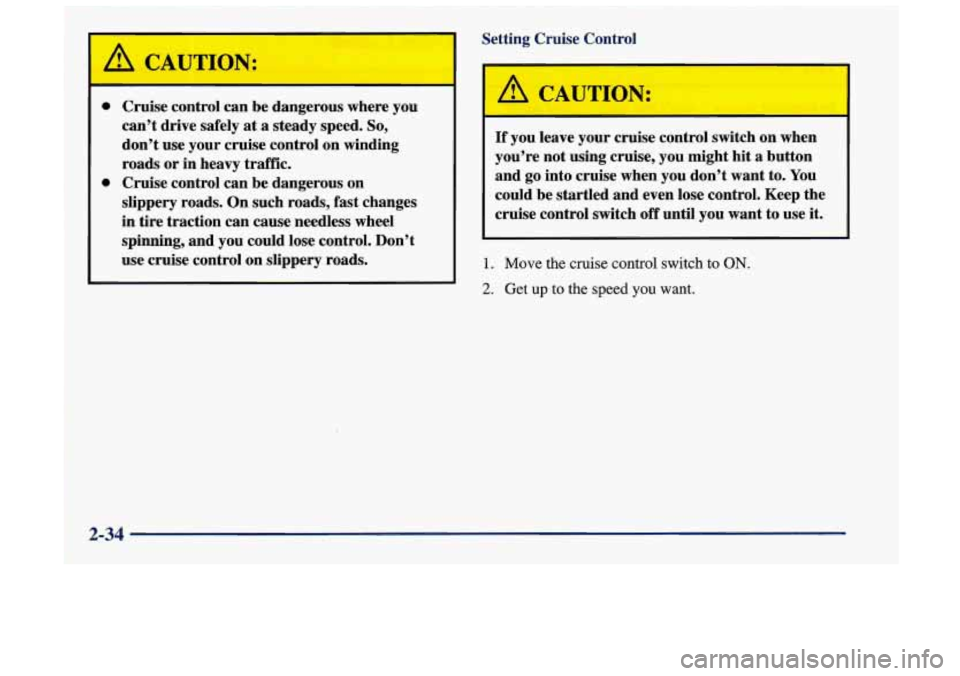
Cruise control can be dangerous where you
can’t drive safely
at a steady speed. So,
don’t use your cruise control on winding
roads or in heavy traffic.
Cruise control can be dangerous on
slippery roads. On such roads, fast changes
in tire traction can cause needless wheel
spinning, and you could lose control. Don’t
use cruise control on slippery roads. Setting Cruise
Control
‘ CA’TTION:
-
If you leave your cruise control switch on when
you’re not using cruise, you might hit
a button
and go into cruise when you don’t want to. You
could be startled and even lose control. Keep the
cruise control switch off until you want to use
it.
1. Move the cruise control switch to ON.
2. Get up to the speed you want.
2-34
Page 99 of 356
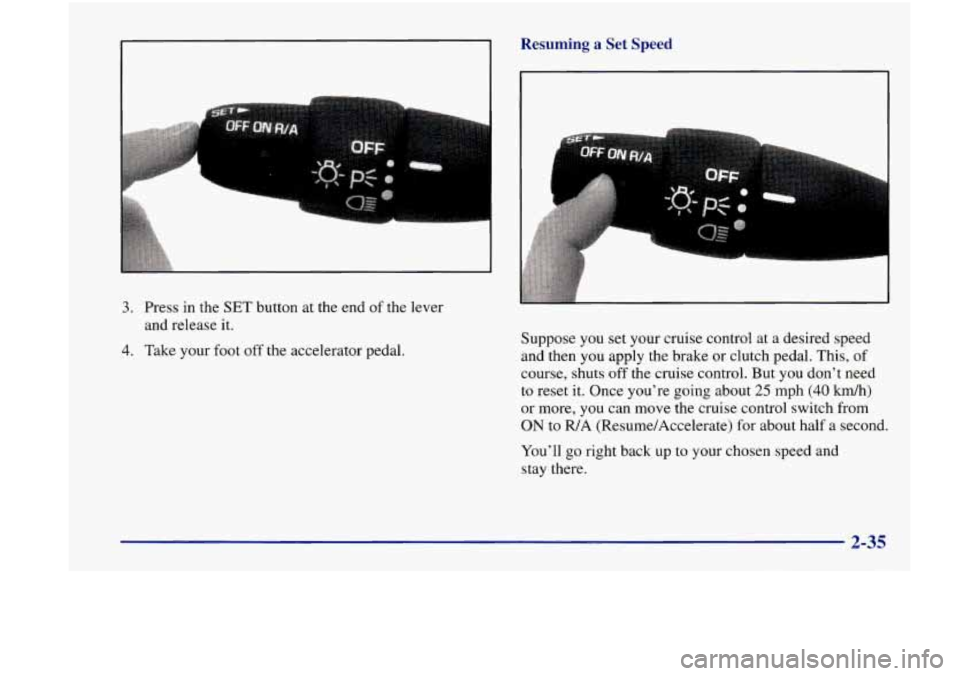
Resuming a Set Speed
I
L. ..
3. Press in the SET button at the end of the lever
and release
it.
4. Take your foot off the accelerator pedal. Suppose
you set your cruise control at a desired speed
and then you apply the brake or clutch pedal. This, of
course, shuts off the cruise control. But you don't need
to reset it. Once you're going about 25 mph (40 kmh)
or more, you can move the cruise control switch from
ON to WA (Resume/Accelerate) for about half a second.
You'll
go right back up to your chosen speed and
stay there.
2-35
Page 100 of 356
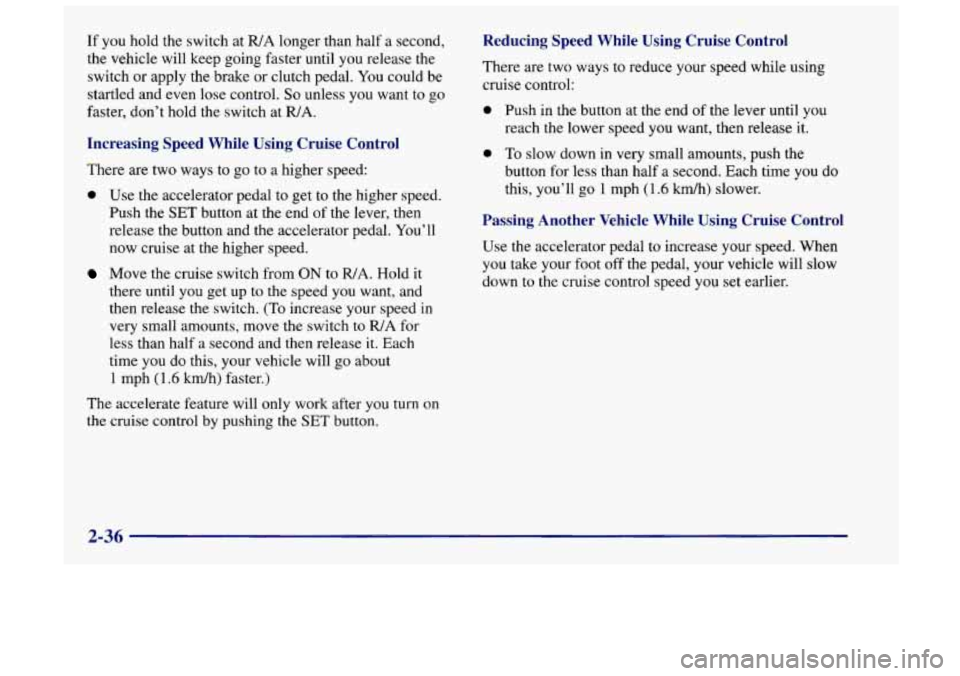
If you hold the switch at WA longer than half a second,
the vehicle will keep going faster until you release the
switch or apply the brake or clutch pedal. You could be
startled and even lose control.
So unless you want to go
faster, don’t hold the switch at WA.
Increasing Speed While Using Cruise Control
There are two ways to go to a higher speed:
0 Use the accelerator pedal to get to the higher speed.
Push the
SET button at the end of the lever, then
release the button and the accelerator pedal. You’ll
now cruise at the higher speed.
Move the cruise switch from ON to WA. Hold it
there until you get up
to the speed you want, and
then release the switch. (To increase your speed in
very small amounts, move the switch to
WA for
less than half a second and then release it. Each
time you do this, your vehicle will go about
1 mph (1.6 km/h) faster.)
The accelerate feature will only work after you turn on
the cruise control by pushing the
SET button.
Reducing Speed While Using Cruise Control
There are two ways to reduce your speed while using
cruise control:
0 Push in the button at the end of the lever until you
reach the lower speed
you want, then release it.
0 To slow down in very small amounts, push the
button for less than half a second. Each time you do
this, you’ll go
1 mph (1.6 km/h) slower.
Passing Another Vehicle While Using Cruise Control
Use the accelerator pedal to increase your speed. When
you take your foot off the pedal, your vehicle will slow
down to the cruise control speed
you set earlier.
2-36
Page 101 of 356
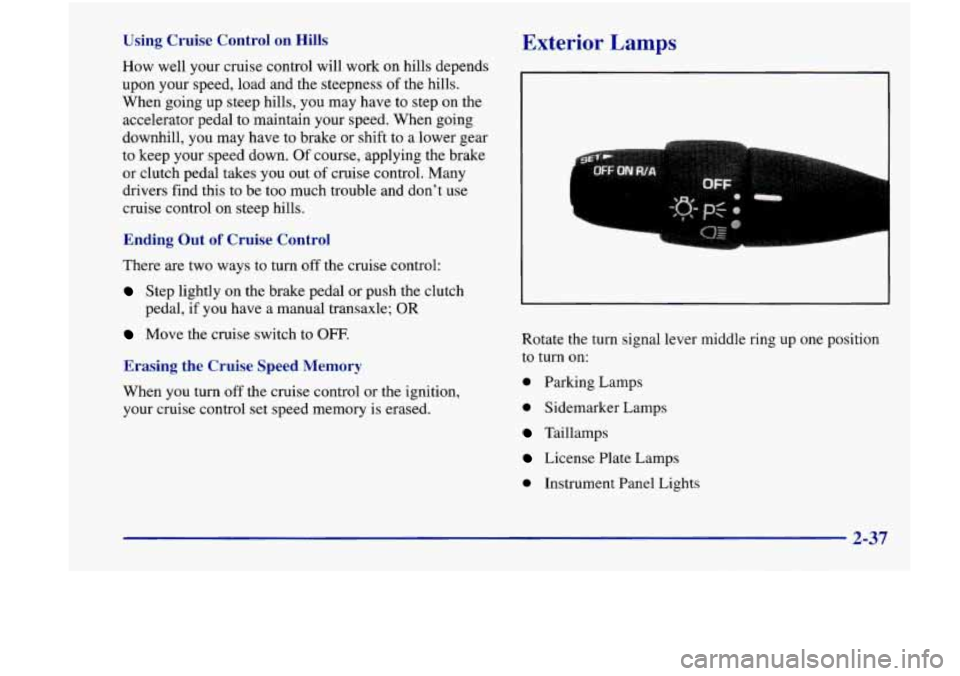
Using Cruise Control on Hills
How well your cruise control will work on hills depends
upon your speed, load and the steepness of the hills.
When going up steep hills, you may have
to step on the
accelerator pedal to maintain your speed. When going
downhill, you may have to brake or shift to a lower gear
to keep your speed down. Of course, applying the brake
or clutch pedal takes you out of cruise control. Many
drivers find this to be too much trouble and don’t use
cruise control on steep hills.
Ending Out of Cruise Control
Exterior Lamps
There are two ways to turn off the cruise control:
Step lightly on the brake pedal or push the clutch
pedal,
if you have a manual transaxle; OR
Move the cruise switch to OFF.
Erasine the Cruise Speed Memory
When you turn off the cruise control or the ignition,
your cruise control set speed memory is erased.
I
Rotate the turn signal lever middle ring up one position
to turn on:
0 Parking Lamps
0 Sidemarker Lamps
Taillamps
License Plate Lamps
0 Instrument Panel Lights
2-37
Page 123 of 356
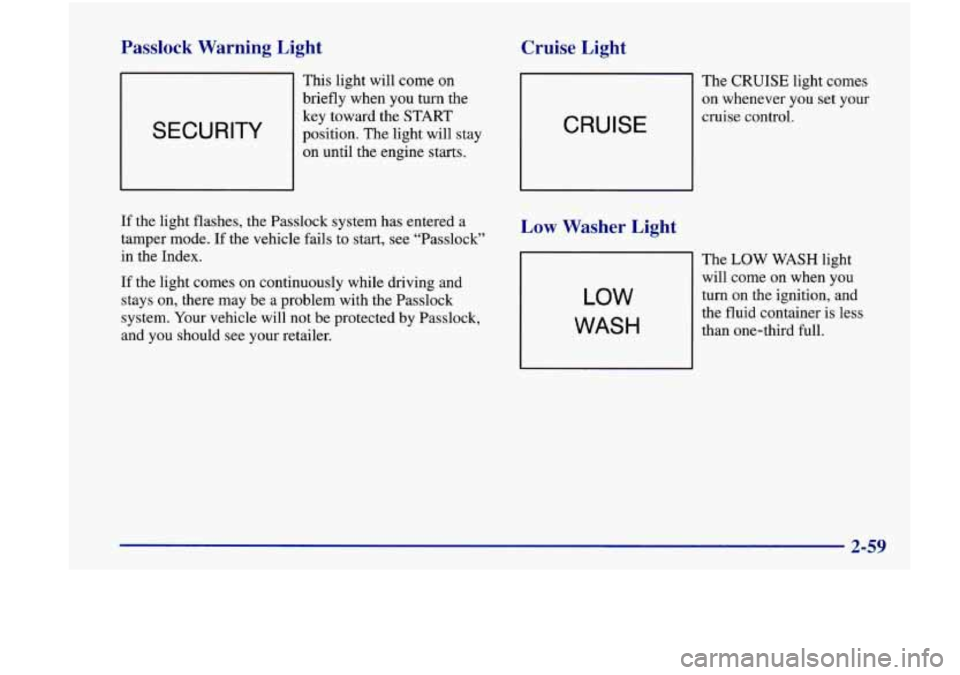
Passlock Warning Light
SECURITY
This light will come on
briefly when you turn the
key toward the
START
position. The light will stay
on until the engine starts.
Cruise Light
The CRUISE light comes
on whenever you set your
CRUISE
cruise control.
If the light flashes, the Passlock system has entered a
tamper mode. If the vehicle fails to start, see “Passlock”
in the Index.
If the light comes on continuously while driving and
stays on, there may be a problem with the Passlock
system. Your vehicle will not be protected by Passlock,
and you should see your retailer.
Low Washer Light
LOW
WASH
The LOW WASH light
will come on when you
turn on the ignition, and
the fluid container is less
than one-third full.
Page 283 of 356
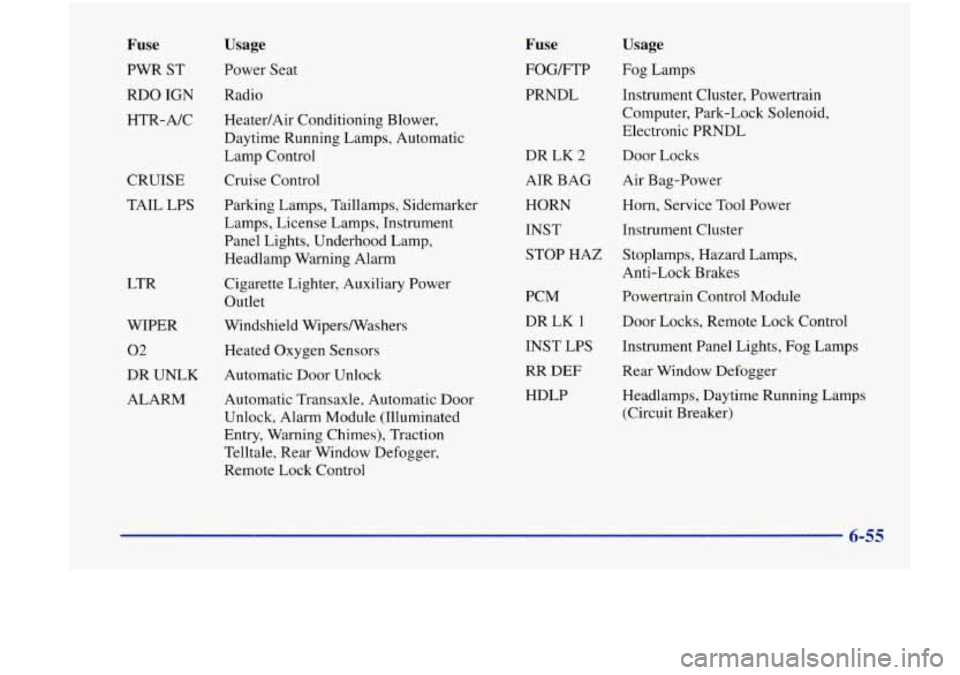
Fuse
PWR ST
RDO IGN
HTR-A/C
CRUISE
TAIL LPS
LTR
WIPER
Usage
Power Seat
Radio
Heater/Air Conditioning Blower,
Daytime Running Lamps, Automatic
Lamp Control
Cruise Control
Parking Lamps, Taillamps, Sidemarker
Lamps, License Lamps, Instrument
Panel Lights, Underhood Lamp,
Headlamp Warning Alarm
Cigarette Lighter, Auxiliary Power
Outlet
Windshield Wipers/Washers
02 Heated Oxygen Sensors
DR UNLK Automatic Door Unlock
ALARM Automatic Transaxle, Automatic Door
Unlock, Alarm Module (Illuminated
Entry, Warning Chimes), Traction Telltale, Rear Window Defogger,
Remote Lock Control
Fuse
FOGLFTP
PRNDL
DR LK
2
AIR BAG
HORN
Usage
Fog Lamps
Instrument Cluster, Powertrain
Computer, Park-Lock Solenoid,
Electronic PRNDL
Door Locks
Air Bag-Power
Horn, Service Tool Power
INST Instrument Cluster
STOP HAZ Stoplamps, Hazard Lamps,
Anti-Lock Brakes
PCM
DR LK 1
INST LPS
RR DEF
HDLP
Powertrain Control Module
Door Locks, Remote Lock Control
Instrument Panel Lights, Fog Lamps
Rear Window Defogger
Headlamps, Daytime Running Lamps (Circuit Breaker)
6-55
Page 324 of 356
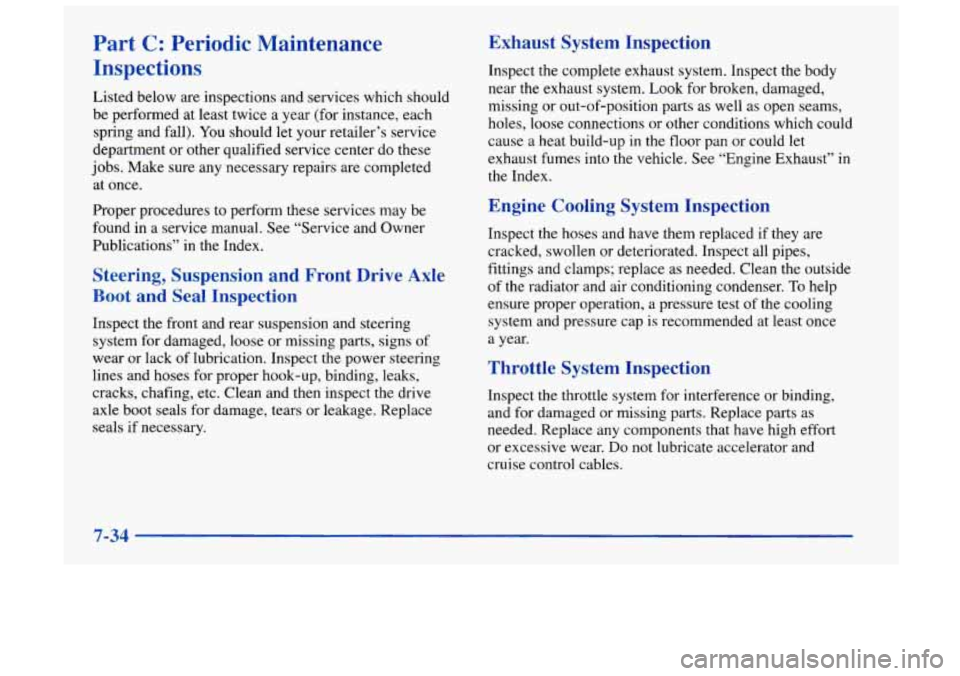
Part C: Periodic Maintenance
Inspections
Listed below are inspections and services which should
be performed at least twice a year (for instance, each
spring and fall). You should let your retailer’s service
department or other qualified service center do these
jobs. Make sure any necessary repairs are completed
at once.
Proper procedures to perform these services may be
found in a service manual. See “Service and Owner
Publications” in the Index.
Steering, Suspension and Front Drive Axle
Boot
and Seal Inspection
Inspect the front and rear suspension and steering
system for damaged, loose or missing parts, signs of
wear or lack
of lubrication. Inspect the power steering
lines and hoses for proper hook-up, binding, leaks,
cracks, chafing, etc. Clean and then inspect the drive
axle boot seals for damage, tears or leakage. Replace
seals if necessary.
Exhaust System Inspection
Inspect the complete exhaust system. Inspect the body
near the exhaust system. Look for broken, damaged,
missing or out-of-position parts as well as open seams,
holes, loose connections or other conditions which could
cause a
heat build-up in the floor pan or could let
exhaust fumes into the vehicle. See “Engine Exhaust’’ in
the Index.
Engine Cooling System Inspection
Inspect the hoses and have them replaced if they are
cracked, swollen
or deteriorated. Inspect all pipes,
fittings and clamps; replace as needed. Clean the outside
of the radiator and air conditioning condenser.
To help
ensure proper operation, a pressure
test of the cooling
system and pressure cap
is recommended at least once
a year.
Throttle System Inspection
Inspect the throttle system for interference or binding,
and for damaged or missing parts. Replace parts as
needed. Replace any components that have high effort
or excessive wear.
Do not lubricate accelerator and
cruise control cables.
7-34
Page 345 of 356
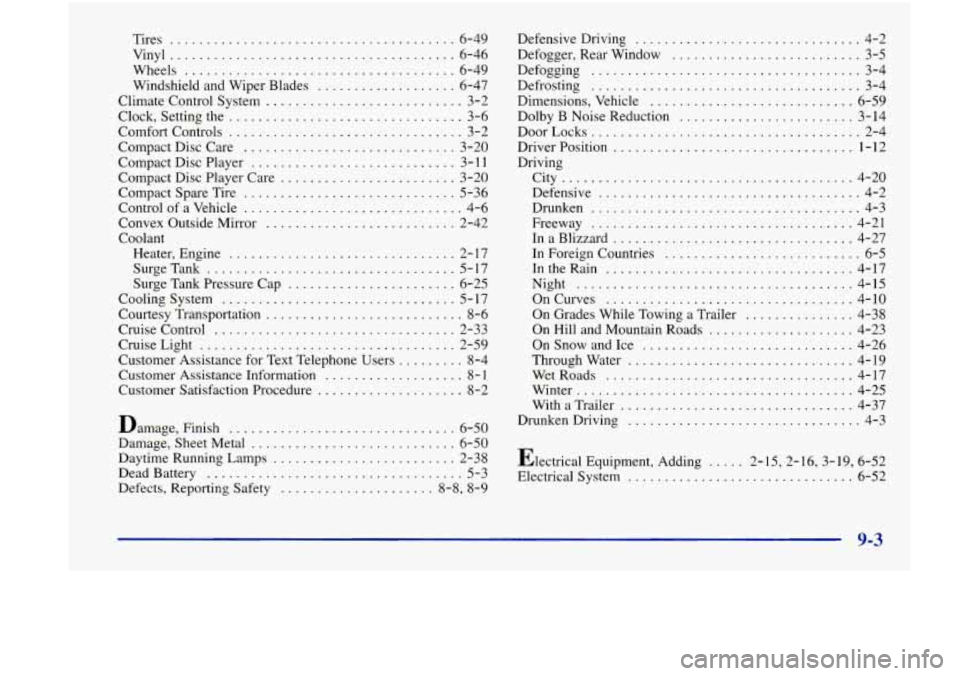
Tires ....................................... 6-49
Vinyl
....................................... 6-46
Wheels
..................................... 6-49
Windshield and Wiper Blades
................... 6-47
Climate Control System
........................... 3-2
Clock. Setting the
................................ 3-6
Comfort Controls
................................ 3-2
Compact Disc Care
............................. 3-20
Compact Disc Player
............................ 3- 1 1
Compact Disc Player Care ........................ 3-20
Compact Spare Tire
............................. 5-36
Control of a Vehicle
.............................. 4-6
Convex Outside Mirror
.......................... 2-42
Coolant Heater. Engine
............................... 2-17
Surge Tank Pressure Cap
....................... 6-25
Cooling System
................................ 5-17
Courtesy Transportation
........................... 8-6
Cruise Control
................................. 2-33
Cruise Light
................................... 2-59
Customer Assistance Information
................... 8- 1
Customer Satisfaction Procedure .................... 8-2
SurgeTank
.................................. 5-17
Customer Assistance for
Text Telephone Users ......... 8-4
Damage. Finish
............................... 6-50
Damage. Sheet Metal
............................ 6-50
Daytime Running Lamps
......................... 2-38
DeadBattery
................................... 5-3
Defects. Reporting Safety ..................... 8.8. 8.9 Defensive Driving
............................... 4-2
Defogger. Rear Window
.......................... 3-5
Defogging
..................................... 3-4
Defrosting ..................................... 3-4
Dimensions. Vehicle
............................ 6-59
Dolby
B Noise Reduction ........................ 3-14
DoorLocks
..................................... 2-4
Driver Position
................................. 1 . 12
Driving
City
........................................ 4-20
Defensive
.................................... 4-2
Drunken
..................................... 4-3
Freeway
.................................... 4-21
InaBlizzard
................................. 4-27
In Foreign Countries
........................... 6-5
IntheRain .................................. 4-17
Night
...................................... 4-15
OnCurves
.................................. 4-10
On Grades While Towing
a Trailer ............... 4-38
On Hill and Mountain Roads
.................... 4-23
OnSnowandIce
............................. 4-26
Throughwater
............................... 4-19
WetRoads .................................. 4-17
Winter
...................................... 4-25
With a Trailer
................................ 4-37
Drunken Driving
................................ 4-3
Electrical Equipment. Adding
..... 2- 15. 2- 16. 3-19. 6-52
Electrical System
............................... 6-52
9-3